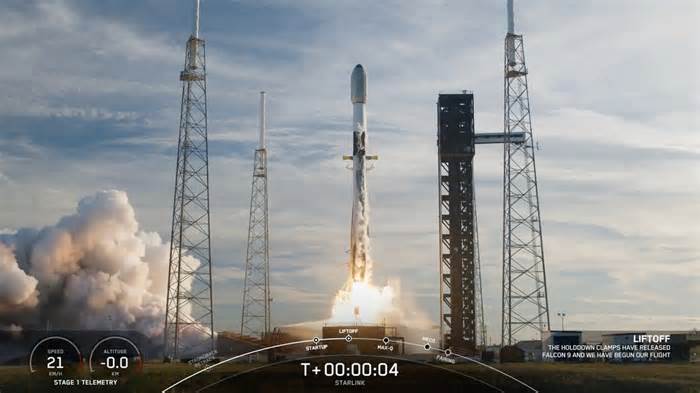SpaceX launched another batch of its Starlink internet satellites from Florida’s Space Coast today (Jan. 27).
A Falcon 9 rocket carrying 21 Starlink spacecraft, including 13 with direct-to-cellphone capability, lifted off from Cape Canaveral Space Force Station today at 5:05 p.m. EST (2205 GMT).
The Falcon 9’s first stage returned to Earth about eight minutes after liftoff as planned, touching down in the Atlantic Ocean on the SpaceX drone ship “A Shortfall of Gravitas.”
Today’s flight was the 20th launch and landing for this particular booster, according to a SpaceX mission description. Eleven of its 20 flights have been Starlink missions.
The Falcon 9’s upper stage, meanwhile, continued carrying the 21 Starlink satellites to low Earth orbit. It will deploy them there about 65 minutes after liftoff.
Related: Starlink satellite train: how to see and track it in the night sky
— SpaceX: Facts about Elon Musk’s private spaceflight company
— Starlink satellites: Facts, tracking and impact on astronomy
— SpaceX Falcon 9 rocket launches on record-breaking 24th flight (video)
SpaceX has now launched 12 Falcon 9 missions in 2025, eight of them Starlink flights.
The Starlink megaconstellation — the biggest ever assembled — currently consists of more than 6,900 operational spacecraft, according to astrophysicist and satellite tracker Jonathan McDowell.
Editor’s note: This story was updated at 5:20 p.m. ET on Jan. 27 with news of successful launch and rocket landing.
Join our Space Forums to keep talking space on the latest missions, night sky and more! And if you have a news tip, correction or comment, let us know at: [email protected].
Michael Wall is a Senior Space Writer with Space.com and joined the team in 2010. He primarily covers exoplanets, spaceflight and military space, but has been known to dabble in the space art beat. His book about the search for alien life, “Out There,” was published on Nov. 13, 2018. Before becoming a science writer, Michael worked as a herpetologist and wildlife biologist. He has a Ph.D. in evolutionary biology from the University of Sydney, Australia, a bachelor’s degree from the University of Arizona, and a graduate certificate in science writing from the University of California, Santa Cruz. To find out what his latest project is, you can follow Michael on Twitter.
Trump wants US to pursue ‘manifest destiny’ in space. What could that mean?
This Week In Space podcast: Episode 145 — We’re ‘Star Bound’ with a guide to America’s space program
Supermassive black holes in ‘little red dot’ galaxies are 1,000 times larger than they should be, and astronomers don’t know why
Space is part of Future US Inc, an international media group and leading digital publisher. Visit our corporate site.

